Titel BigBangBeijing
Autor Hiromasa Shirai und André Schmidt
mit Charles Berman, Tessa Boid-Caine, Jin Chong, Keru Feng, Rem Koolhaas, Michelle Liu, Brendan McGetrick, Barbara Münch
Herausgeber Koichi Kajima
Verlag/Copyright First Published in Japan, 30. October 2007 by Kajima Institute Publishing Co., Ltd.
Design Hiromasa Shirai + André Schmidt / Kenji Tsuji (Thinks)
Druck Printed in Japan
ISBN 978-4-306-04485-2 C3052
Observation by Rem Koolhaas
For 5 years this was my regular view.
Apart from the seasons and the weather it never changed: "old" China of the Forbidden City to the right, separated by a red wall from the current China, to the left. At the other end of the road that bisected the picture, we were working, we hoped, on a new China.
It was a view that I never took for granted. It always made me look more and more intensely. There were many things I liked in the picture; the persistent delicacy of Chineseness in the foreground, the grayness of the government building, the disciplined exuberance of the flags. In spite of the apparent stability and predictability of the image, the system had produced, over the last 60 years, drastic changes accumulated colossal amounts of power and money. It was, in fact, the perfect image of a system.
After first reinventing itself, it became more and more clear – in the 5 years that I analyzed the view - that the system was now prepared to reinvent the world...
The view never changed, but its meaning was never quite the same.
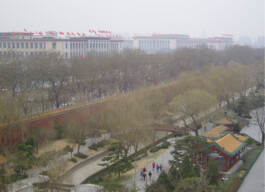
Picture by Rem Koolhaas
Foreword by Brendan McGetrick
To much applause and hand-wringing, China undergoes the world's most extreme makeover. Cities of millions have sprung from nothing, millennia-old communities have been razed overnight, populations displaced, peasants turned millionaires, bicycles turned Bentleys, oil, concrete, and steel consumed at unfathomable rates, uncountable fingers lost to Walmart and Adidas, and on and on... The story of China's transformation from PRC to "the new USA" is well worn, almost worn out. Beijing, government seat and Olympic host, is the main actor, and can boast its own set of incredible growth stats: for one, it's estimated that the equivalent of three Manhattans will be added to the city by 2008.
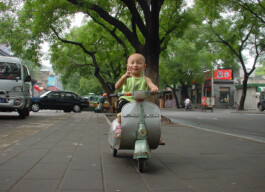
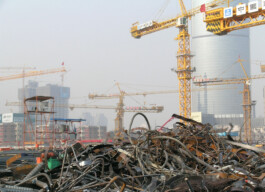
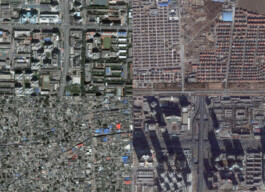
The Olympics will be Beijing's coming out, and throughout the city there is an atmosphere of hope, pride, and ambition that is exhilarating. The desire for newness - new hobbies, new houses, new clothes and types of food... - is apparent everywhere. But that's only part of the story. Even amongst the frenzied upgrading, Beijing retains much of its former self. As the center of civilization, it draws in people from all parts of China, making a wholesale abandonment of old ways impossible. It is this mixture - the merging of the past with an imagined future - that Hiromasa and Andre capture in their photos.
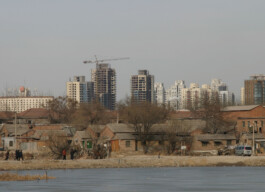
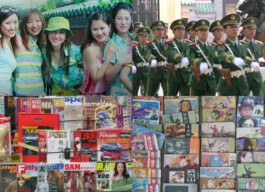
As a visitor, the Beijing cityscape often feels like a jumble of demolition, construction, and stage sets. With so much of its historic substance altered or erased, first by ideologues now by speculators, there's a sense of discontinuity that marks Beijing out among the world's ancient capitals. "Heritage" is essential to its value as a tourist destination and propaganda tool, but much of it has been reformatted especially for those purposes. Often, the clearest links to Beijing's past are human, preserved in patterns of life that go back centuries and that somehow managed to survive the turmoil of the past century.
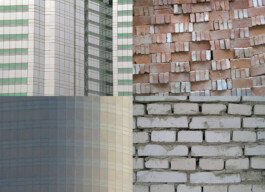
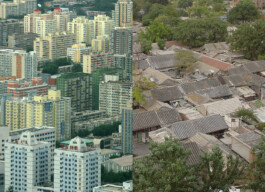
Big Bang Beijing documents a few remnants of Beijing's pre-modern life. One picture shows a congested alleyway lined with vendors. In the background, the skeleton of a future skyscraper blocks off the horizon. There's a strong sense of impermanence and mobility, like it all could be gone tomorrow. The feeling returns later in several snapshots of the city's bicycle businesses. Predictable services like food delivery and taxis are combined with less obvious possibilities like mobile hardware stores and recycling centers, implying a system of circulating service capable of surviving any amount of urban instability. In both sets of images, the people featured share a common demeanor, an expression of intelligent weariness that I think is as much as part of quintessential Beijing as Mao's mausoleum or the rebuilt Wall.
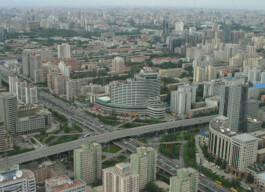
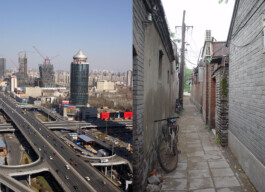
The "threat" to these artifacts drives the book's other major theme, new construction - depicted in photos of real estate expos, utopian billboards, artificial landscaping and monumental infrastructure. It's tempting to pit the two forces against each other - culture vs construction, people vs. progress - and many popular depictions of Beijing do just that. But BBB avoids that reduction. Andre and Hiromasa's photos don't mourn the city's past or fear its future; instead they fixate, almost compulsively, on the present. Strung together, they provide a personal account of an evolving city, expanding and contracting, as it forges a path toward a dream.
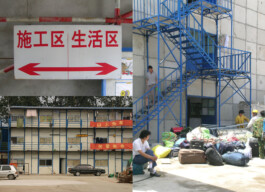
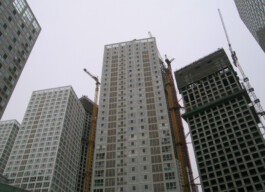
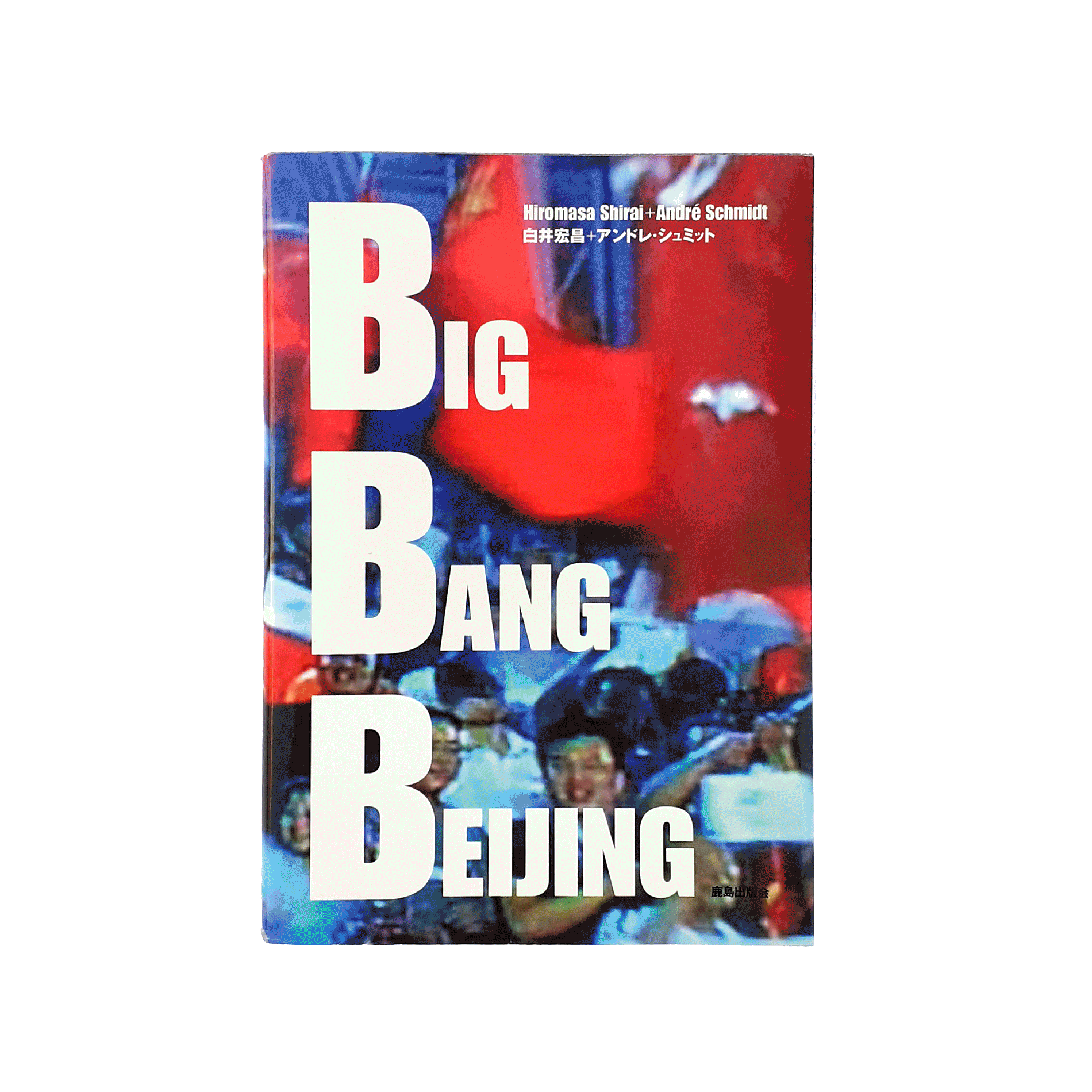
Titel BigBangBeijing
Autor Hiromasa Shirai und André Schmidt
mit Charles Berman, Tessa Boid-Caine, Jin Chong, Keru Feng, Rem Koolhaas, Michelle Liu, Brendan McGetrick, Barbara Münch
Herausgeber Koichi Kajima
Verlag/Copyright First Published in Japan, 30. October 2007 by Kajima Institute Publishing Co., Ltd.
Design Hiromasa Shirai + André Schmidt / Kenji Tsuji (Thinks)
Druck Printed in Japan
ISBN 978-4-306-04485-2 C3052

Picture by Rem Koolhaas
Observation by Rem Koolhaas
For 5 years this was my regular view.
Apart from the seasons and the weather it never changed: "old" China of the Forbidden City to the right, separated by a red wall from the current China, to the left. At the other end of the road that bisected the picture, we were working, we hoped, on a new China.
It was a view that I never took for granted. It always made me look more and more intensely. There were many things I liked in the picture; the persistent delicacy of Chineseness in the foreground, the grayness of the government building, the disciplined exuberance of the flags. In spite of the apparent stability and predictability of the image, the system had produced, over the last 60 years, drastic changes accumulated colossal amounts of power and money. It was, in fact, the perfect image of a system.
After first reinventing itself, it became more and more clear – in the 5 years that I analyzed the view - that the system was now prepared to reinvent the world...
The view never changed, but its meaning was never quite the same.
Big Bang Beijing

Foreword by Brendan McGetrick
To much applause and hand-wringing, China undergoes the world's most extreme makeover. Cities of millions have sprung from nothing, millennia-old communities have been razed overnight, populations displaced, peasants turned millionaires, bicycles turned Bentleys, oil, concrete, and steel consumed at unfathomable rates, uncountable fingers lost to Walmart and Adidas, and on and on... The story of China's transformation from PRC to "the new USA" is well worn, almost worn out. Beijing, government seat and Olympic host, is the main actor, and can boast its own set of incredible growth stats: for one, it's estimated that the equivalent of three Manhattans will be added to the city by 2008.


The Olympics will be Beijing's coming out, and throughout the city there is an atmosphere of hope, pride, and ambition that is exhilarating. The desire for newness - new hobbies, new houses, new clothes and types of food... - is apparent everywhere. But that's only part of the story. Even amongst the frenzied upgrading, Beijing retains much of its former self. As the center of civilization, it draws in people from all parts of China, making a wholesale abandonment of old ways impossible. It is this mixture - the merging of the past with an imagined future - that Hiromasa and Andre capture in their photos.


As a visitor, the Beijing cityscape often feels like a jumble of demolition, construction, and stage sets. With so much of its historic substance altered or erased, first by ideologues now by speculators, there's a sense of discontinuity that marks Beijing out among the world's ancient capitals. "Heritage" is essential to its value as a tourist destination and propaganda tool, but much of it has been reformatted especially for those purposes. Often, the clearest links to Beijing's past are human, preserved in patterns of life that go back centuries and that somehow managed to survive the turmoil of the past century.


Big Bang Beijing documents a few remnants of Beijing's pre-modern life. One picture shows a congested alleyway lined with vendors. In the background, the skeleton of a future skyscraper blocks off the horizon. There's a strong sense of impermanence and mobility, like it all could be gone tomorrow. The feeling returns later in several snapshots of the city's bicycle businesses. Predictable services like food delivery and taxis are combined with less obvious possibilities like mobile hardware stores and recycling centers, implying a system of circulating service capable of surviving any amount of urban instability. In both sets of images, the people featured share a common demeanor, an expression of intelligent weariness that I think is as much as part of quintessential Beijing as Mao's mausoleum or the rebuilt Wall.


The "threat" to these artifacts drives the book's other major theme, new construction - depicted in photos of real estate expos, utopian billboards, artificial landscaping and monumental infrastructure. It's tempting to pit the two forces against each other - culture vs construction, people vs. progress - and many popular depictions of Beijing do just that. But BBB avoids that reduction. Andre and Hiromasa's photos don't mourn the city's past or fear its future; instead they fixate, almost compulsively, on the present. Strung together, they provide a personal account of an evolving city, expanding and contracting, as it forges a path toward a dream.

